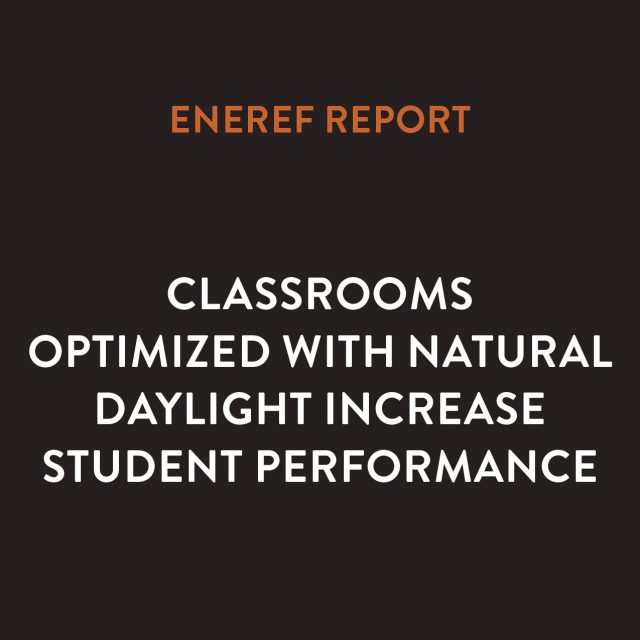
Get Inspired. Lead Others. Drive Change.


Eneref Institute examines how a polished concrete floor reduces maintenance costs for a performing arts school.
“It’s an all-around perfect fit for any school.”
Eneref Institute examines the benefits of lighting controls with natural interior daylight in classrooms.
“It really brought the daylight and the outside into the middle of the facility. It brought the scho...
Eneref Institute examines how the number of patrons using the library increases with the installation of skylights.
“Having beautiful spaces was really important and a large part of that was having daylight available...
Architects Choose Modular Glass Skylights For Cornell University
“It’s a really well built, well detailed, high thermal performance skylight. It’s super cost-afforda...Student Hours Indoors
Student Hours in Classroom
Students spend 1260 hours inside a school building, representing 14% of their day.
Quality Indoor Environment Improves Learning
On March 3rd, 2019, Eneref Institute wrote a letter to school executives across the country imploring that natural interior daylight be used for classroom lighting.
“The right daylight design in classrooms can improve student test scores.”
Read full text of press release.
We Can All Take Actions
What to Do
The first step to effect change is to conduct a thorough search about how to communicate with your state’s School Board of Education and School Facilities Board to demand the adoption of policies that guard students’ wellness. Discover your state Boards’ optimal timetables to receive public comments, written or oral, prior to meetings in which the implementation of new regulations will be considered. Furthermore, you can attend public meetings or feedback sessions conducted by the state Boards and register for a timeslot to speak directly to the executives. Finally, get involved in the schools’ family and community engagement programs. Make sure that your voice is heard and that your concerns are addressed so that younger generations have #WellnessFriendlySchools.
What to Know
- FILTRATION SYSTEMS IMPROVE INDOOR AIR QUALITY AT SCHOOLS
Better filtration will not only prepare school districts for the next infectious disease but will create immediate IAQ benefits for over 50 million students. EPA’s Science Advisory Board consistently ranks indoor air pollution among the top five environmental risks to public health, as indoor contaminants can be as much as one hundred times higher than outdoor levels. Beyond increasing exposure to respiratory viruses, poor indoor air in schools has been shown to aggravate asthma, allergies, and other respiratory illnesses in students.
- MERV-13 FILTRATION PROTECTS STUDENTS HEALTH
MERV-13 filtration in air conditioning systems reduce students’ risk of viral transmission and exposure to environmental health hazards. Many existing HVAC systems were designed using MERV-8 filters or less, yet MERV-13 filters are five times more effective at capturing respiratory droplets and reducing viral concentration. MERV-13 filtration can help protect students from contracting the SARS-CoV-2 virus.
- STUDENTS PERFORM BETTER UNDER NATURAL DAYLIGHT
There is plenty of evidence that daylighting improves occupant productivity in both schools and offices. Especially in learning environments, skylit classrooms provide a natural and stimulating space for teacher and student. While studies show that poor lighting adversely affects learning, daylighting has been proven to increase student performance in math and reading scores, as well as improving attendance.
- TEACHERS PERFORM BETTER UNDER NATURAL INTERIOR DAYLIGHT
Studies show that teachers have fewer sick days. The human performance numbers in daylighting systems are important because the ROI for daylighting installations can sometimes be a difficult sell. In fact, the human performance gains can outweigh the energy savings, where human performance can be measured in financial terms.
- POLISHED CONCRETE SYSTEMS BRING A VARIETY OF BENEFITS TO SCHOOLS
Sustainability, which is indispensable for students’ wellness, can be incorporated into schools with polished concrete floors. Polished concrete floors also enhance the aesthetic of the building while reducing maintenance costs. These systems’ durability is greatly appealing and they are a good fit for the high-traffic needs of a school.
- INCORPORATING HUMAN-FOCUSED DESIGN INTO BUILDINGS IMPROVES PRODUCTIVITY
A healthy school environment boosts not only employee productivity but also student performance by optimizing comfort, morale and attitude. There is a direct relationship between academic achievement and health-related behaviors. What is more, a building’s increased health-oriented features reduce the risk of stress-related illnesses and heart disease.



